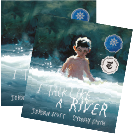I do not stutter because I am nervous.
I do not stutter because I am weak or fearful. I do not stutter because I’m unintelligent.
I do not need help finishing my thoughts.
I do not need help saying what I am about to say.
When I was a boy my dad would sometimes pick me up from school on ‘bad speech days’ and take me down to the river. On those days, my mouth would just stop working. Every word was painful; the laughter from classmates unbearable. I just wanted to be quiet. Along the river we skipped stones, watched for salmon, picked up bugs, and plucked blackberries, all without saying a word.
One particular day, while watching the water move against the shore, my dad said: “You see how that water moves, son? That’s how you speak.” Since then I have always imagined that my teeth grinding on difficult words are like plate tectonics, my chin spasms are bee swarms.
Stuttering is often mocked because it is seen as unnatural. For many, listening to and watching someone stutter is not a comfortable experience because language and sound are stretched to their limits. Strange noises burst from a contorting mouth and what the listener thinks of fluency or ‘normal speech’ explodes. To stutter is to be dysfluent; and fluency, my speech therapist used to say, ‘is the ultimate goal.’
But at the river, I learned to think differently about fluency. The river has a mouth, a confluence, a flow. The river is a natural and patient form, forever making its way toward something greater than itself. Yet as the river moves, it stutters, and I do too.
Take a moment to listen to the way you talk. How do you sound? What would happen if you concentrated on the feeling of speaking? Where do you feel words in your body? Do you speak without pauses or hesitations? How often do you slip up, forget words, or have difficulty finding them in the first place? Do you sometimes shy away from speaking? Do you sometimes not want to say anything at all?
My dad took me to the river to feel less alone. When he pointed to the river, he gave image and language to talk about something so private and terrifying. In doing so, he connected my stuttering to the movements of the natural world and I delighted in watching my mouth move outside of itself.
Everyone who stutters does so differently. A stutter is never just a stutter but a set of intricately intimate labours with words, sound, and body. My stutter is my own and also part of larger confluence of dysfluent mouths going about their day: ordering food at a restaurant, making small talk about the weather, or talking to loved ones. Stuttering makes me feel profoundly connected and profoundly alone. Stuttering is terrifyingly beautiful. Sometimes I want to speak without worrying; sometimes I want to speak with grace, finesse, and with all those words you can think of for smooth. But that is not me. I talk like a river.
This book is a continuation of a decade’s long inquiry into the poetics of stuttering and cultural representations of dysfluency. In I Talk Like A River, I wanted to find a way to share this knowledge with children and hopefully change the way stuttering is perceived.
I have heard stuttering described as a medical condition, an issue of mental capacity and stamina. Even Joe Biden’s intelligence was questioned by senior politicians who don’t understand what a stutter means. It’s these kinds of false connections between stuttering and intelligence that makes it so difficult to live in the world as a stutterer.
When speaking, don’t we all forget words? Don’t we all hesitate or pause? Don’t we all sometimes wish we said something else or found a better word to express ourselves?
This is what I often refer to as the regime of fluency or a structure of continually promulgated beliefs about how someone should sound or speak in order to be considered credible and intelligent.
I think fluency is a fiction.
For More Information
https://holidayhouse.com/book/i-talk-like-a-river/
@jscottwrites

Cover – Courtesy of Holiday House Publishing, Inc. Interiors – Text copyright © 2020 by Jordan Scott Illustrations copyright © 2020 by Sydney Smith
Please login to view this content
Login